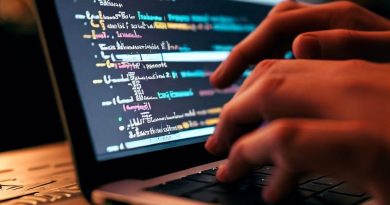Balancing Screen Time and Coding Classes for Kids
Last Updated on January 27, 2024
Introduction
The importance of balancing screen time and coding classes for kids cannot be stressed enough.
Excessive screen time can have negative effects on children, which is why teaching them coding skills is crucial.
When children spend too much time in front of screens, such as computers, tablets, or smartphones, it can lead to various health and developmental issues.
This includes eye strain, sedentary lifestyle, reduced social interactions, and decreased physical activities.
On the other hand, coding classes offer numerous benefits to kids.
Learning coding skills not only empowers them to create and innovate but also enhances problem-solving abilities, critical thinking skills, and logical reasoning.
It is like teaching them a new language that helps them communicate effectively in the digital world.
As parents and educators, it becomes essential to strike a balance between screen time and coding classes.
Instead of completely avoiding screens, it is better to channelize screen time towards productive learning activities like coding.
This way, children can develop vital digital skills while minimizing the potential harm of excessive screen time.
By finding the right balance, children can enjoy the benefits of technology while also fostering their creativity, cognitive abilities, and future career prospects.
It is important to recognize the role of coding classes in equipping kids with the skills they’ll require in the increasingly technological world.
In the following sections, we will explore practical ways to strike this balance, ensuring children have a healthy relationship with screens while also gaining valuable coding skills.
Read: Coding Games for Kids: Learning Can Be Fun!
Benefits of Balancing Screen Time
When it comes to children and their screen time, finding the right balance is crucial.
While excessive screen time can have negative effects on their development, incorporating coding classes can offer a variety of benefits.
Here are some ways balancing screen time can be advantageous for kids:
Enhances Cognitive Development
Coding classes require children to think logically and analytically, which enhances their cognitive abilities.
They learn to break down complex problems into smaller steps, improving their problem-solving skills.
Promotes Problem-Solving and Critical Thinking Skills
Through coding, children are exposed to real-world problems that need to be solved.
They learn to think critically, analyze situations, and come up with innovative solutions.
Fosters Creativity and Innovation
Coding classes provide a creative outlet for children to express their ideas and bring them to life.
They can design games, create animations, and build interactive websites, fostering innovation.
Encourages Collaboration and Teamwork
In coding classes, kids often work on projects together, developing teamwork and collaboration skills.
They learn to communicate, share ideas, and solve problems as a team.
Builds Resilience and Perseverance
Coding can be challenging at times, and children may encounter obstacles or errors.
Through troubleshooting and debugging, they develop resilience and perseverance to overcome challenges.
Basically, balancing screen time by incorporating coding classes for kids offers numerous benefits.
It enhances cognitive development, promotes problem-solving and critical thinking skills, fosters creativity and innovation, encourages collaboration and teamwork, and builds resilience and perseverance.
By finding the right balance, kids can make the most out of their screen time while acquiring valuable skills for the future.
Read: Teaching Kids to Code: Do’s and Don’ts for Parents
Negative Effects of Excessive Screen Time
Excessive screen time can have negative effects on both the physical and psychological health of children.
Impact on physical health (sedentary lifestyle, obesity, eye strain)
One major consequence of spending too much time in front of screens is the impact on physical health.
This sedentary lifestyle promotes a lack of physical activity, leading to a higher risk of obesity and related health conditions.
Another physical effect is eye strain or digital eye strain, also known as computer vision syndrome.
This condition causes discomfort, dryness, and fatigue in the eyes, which can affect a child’s ability to focus.
Furthermore, excessive screen time can have psychological effects as well.
One of the most significant impacts is social isolation.
When children spend too much time with screens, they may miss out on important social interactions and face difficulty in building meaningful relationships.
Psychological effects (social isolation, anxiety, depression)
Additionally, too much screen time has been linked to higher levels of anxiety and depression.
This can be due to the constant exposure to unrealistic standards, cyberbullying, and social media pressures.
Reduced attention span and impaired concentration
In terms of cognitive development, excessive screen time can lead to a reduced attention span and impaired concentration.
The constant stimulation and instant gratification of screens can make it harder for children to concentrate on tasks that require sustained focus or critical thinking.
Disrupted sleep patterns
Disrupted sleep patterns are another negative effect of excessive screen time.
The blue light emitted by screens can interfere with the body’s production of melatonin, a hormone that regulates sleep.
This can result in difficulties falling asleep or experiencing poor-quality sleep.
Considering these negative effects, it is crucial to find a balance between screen time and other activities, such as coding classes.
While coding classes can provide numerous benefits, they should not replace physical activity, face-to-face interactions, or adequate sleep.
As parents or educators, it is important to set limits on screen time and encourage alternative hobbies or activities.
Encouraging outdoor play, engaging in family activities, and promoting regular exercise can help children maintain a healthier lifestyle.
When it comes to coding classes, they can be a valuable learning opportunity for children.
These classes can enhance problem-solving skills, promote creativity, and introduce them to valuable technical skills for future careers.
However, it is essential to strike a balance.
Parents should ensure that coding classes do not dominate a child’s schedule or replace other important activities.
They should prioritize a well-rounded development that includes physical exercise, social interactions, and relaxation.
Generally, excessive screen time can have various negative effects on children’s physical and psychological health.
It is crucial to find a balance between screen time and other activities, such as coding classes, to ensure a well-rounded and healthy development for children.
Read: Is Coding for Kids Just a Trend or a Necessary Skill?

Tips for Balancing Screen Time and Coding Classes
Today, it can be a challenge to find the right balance between screen time and coding classes for kids.
With the increasing influence of technology on our daily lives, it is essential to establish healthy habits and ensure that children are not spending too much time in front of screens.
To help parents navigate this issue, here are some helpful tips for balancing screen time and coding classes:
Set limits
Establish daily or weekly screen time limits to ensure that children have time for other activities.
Specify dedicated time for coding classes and educational activities to prioritize learning.
Teach self-discipline
Encourage children to manage their own screen time responsibly by setting clear expectations.
Set boundaries and consequences for when screen time rules are not followed to promote self-discipline.
Encourage physical activities
Engage in outdoor activities and exercises to balance sedentary time spent in front of screens.
Promote sports or hobbies that don’t involve screens to encourage physical fitness and social interaction.
Provide diverse activities
Encourage children to engage in activities that do not require screens, such as reading books or playing board games.
Emphasize the importance of non-screen activities for a well-rounded development, including problem-solving and creativity.
Offer a variety of interests
Encourage kids to explore different hobbies and interests, both digital and non-digital.
Help them find a balance between screen activities and other hobbies they may enjoy, such as art or music.
By following these tips, parents can ensure that their children have a healthy balance between screen time and coding classes.
It is important to remember that screen time should be a tool for learning and entertainment, rather than a constant presence in children’s lives.
Read: How Coding Skills Can Help Kids in School and Life
Explore Further: Top 7 Security Vulnerabilities in PHP (And How to Fix Them)
Conclusion
It is crucial to emphasize the importance of balancing screen time and coding classes for kids.
While coding classes offer numerous benefits, it is essential to ensure a well-rounded development by limiting screen time.
Parents and educators should take proactive steps in finding the right balance for their children.
By monitoring screen time and encouraging other activities, children can develop a wide range of skills and interests.
It is vital to remember that coding is just one aspect of a child’s development, and they should also engage in physical activities, social interactions, and other hobbies.
By striking a balance between screen time and coding classes, parents can provide their children with a comprehensive and holistic education.


